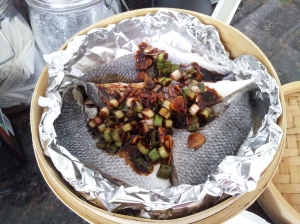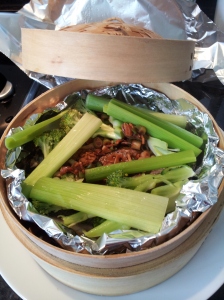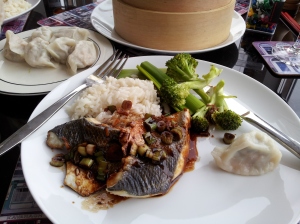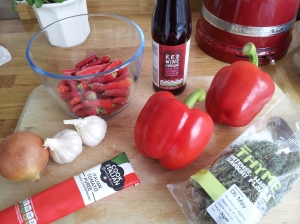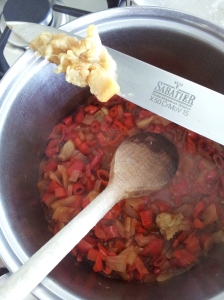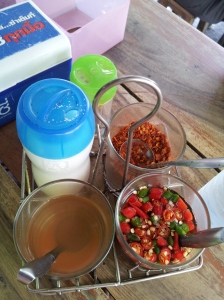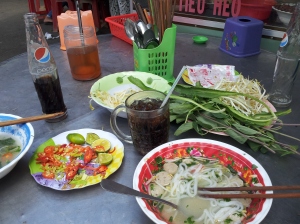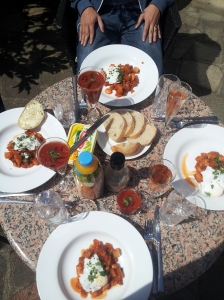
Sunday brunch in the sunshine
When we lived in Dublin, Matt and I went out for brunch a lot. We also made our own at home when the mood struck, especially when we had guests and an idea to test out of them. It’s a brilliant way to eat out cheaply but still have something kinda special, and Dublin was full of amazing places dishing up great food on a Sunday afternoon. From the understated Brother Hubbard with its great coffee, generous portions and rustic cakes, to flashy Cleaver East with its bottomless mimosas and a DJ playing ambient trance – Dublin had a wide variety.
Today Matt and I made brunch for his parents, starting with a Bloody Mary. This is Matt’s specialty and it’s excellent – practically a mini meal all on its own.
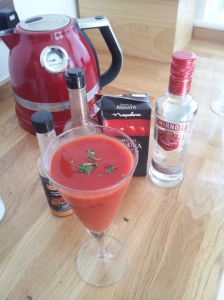
Matt’s Bloody Mary
He mixed a few cubes of ice with 50ml vodka, 100 ml passata, a splash of hot sauce, a splash of Worcestershire sauce, and a big turn of the pepper mill. Once the ice melted a little he gave it a stir and added a bit of chopped coriander for garnish. You will see lots of versions of this drink – some with celery salt on the rim, some with a stick of celery in the glass, and others with a cocktail stick skewering quails eggs or pickles. To be honest, go with whatever you fancy, and adjust it to your taste. This used some of the flavours repeated in the main brunch dish, so it made sense across the meal.
As it was a special brunch, I even set out to make my own bread! I’m not much of a baker usually, as I prefer to just throw unspecified handfuls of ingredients into a pot where baking requires precision. I also don’t have much patience for allowing time to rise and prove, or for having dough sitting in the airing cupboard for half a day. Fortunately this recipe requires none of that hassle which is why I like it so much! So here is my favourite recipe for soda bread. Unfortunately the massive Tesco down the road didn’t stock any buttermilk – about 50 types of rice milk, almond milk, soy milk and a myriad other things, but not one measly carton of buttermilk – so I had to buy a loaf instead. Very frustrating! But I have made it several times before and I promise it’s easy and produces great results.
450g plain white flour
1tsp salt
1tsp bicarbonate of soda
400ml buttermilk
Preheat the oven to 230 degrees. Sift all the dry ingredients into a large bowl. Make a well in the centre and pour in the milk. Using the fingers of one hand like a claw, stir from the centre to the edge of the bowl in circles. The dough should be softish – not too wet and sticky. When it all comes together, turn out onto a well-floured surface. Wash and dry your hands thoroughly. Pat the dough into a round about 4cm thick, and turn over. Transfer to a floured baking tray. Cut a deep cross into the loaf and prick the centre of each quarter. Bake for 15 minutes then reduce the heat to 200 degrees and bake for 30 minutes more or until cooked. To check it’s cooked, tap the bottom – it should sound hollow.
You could have the bread for a nibbly starter – it’s great with a bit of butter or dipped in some good olive oil and most importantly it’s perfect for keeping hungry people out of the kitchen while the main meal is cooking!
So onto the main event! I think brunch should be something a little unusual; as it’s such a luxurious meal anyway I really like the idea of having something a bit special. To me that can mean a good steak, or hollandaise sauce, or buttermilk pancakes, or just an item you’ve never tried before or is too involved to make at home too frequently. I also really think a brunch should include eggs, they’re so cheap and versatile and they go well with any flavour grouping. We made poached eggs with chorizo, bean and potato hash and served it with a bit of bread on the side.
This is a great meal for using up whatever is in the fridge, but here is how we made ours – to serve 4 people.
1/2 a white onion, diced
1 clove garlic, chopped
1 carrot, diced
1 tsp cumin
1 tsp tomato puree
1 tsp chipotle paste (or cut a chipotle pepper in half and throw into the pan, remove before serving)
1 tin butter beans (could use cannellini beans, black eyed beans, chickpeas or similar)
1 tin chopped tomatoes
2 medium potatoes, cubed
1/2 ring of chorizo, roughly chopped
handful of coriander, chopped
4 eggs
2 tbsp red wine vinegar
1 tsp brown sugar
In a large saucepan, fry the garlic, onion and carrot in olive oil for a couple of minutes on a medium heat. Add the cumin and stir for a minute before adding the tomato puree, chipotle paste and red wine vinegar. Throw in the potato, beans and chopped tomatoes, give a stir and leave to simmer for 45 minutes – or until the potatoes are just soft. Taste it as you go and if the mix seems like it needs sugar (ours did) or more vinegar then put in a little bit. The mixture shouldn’t be too liquid, but if it is, just leave simmering a little longer while you cook the eggs.
We poached the eggs, but fried would be amazing too. Or for the total one-pot brunch, try making a couple of wells in the hash and cracking eggs into that. Put the lid on the pan for 5 minutes and allow them to cook that way, and dish up in one lump. Definitely saves on washing up, and time spent at the stove. Whichever method you choose, once plated, grind a little pepper on the top, sprinkle some coriander over it, and serve.
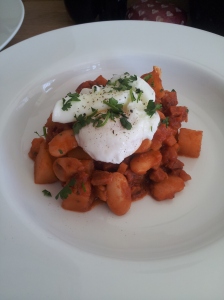
Poached eggs with chorizo, bean and potato hash
Obviously this is a bit of a splurge – my bank account and waistline couldn’t afford to do this every week! But for a special occasion, a date, a get-together with mates, or a visit from the parents, this is an excellent way to while away an afternoon. It’s also an excellent excuse to crack open some bubbly – cheers!



